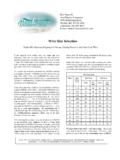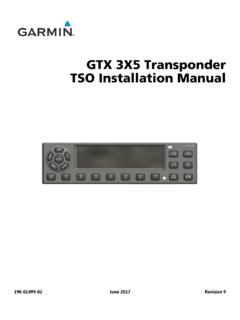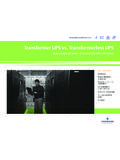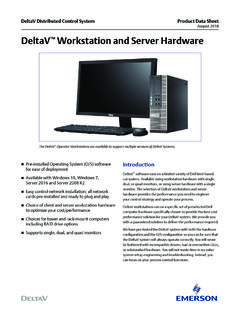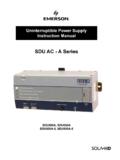Transcription of Effects of AC Ripple Current on VRLA Battery Life
1 A Technical Note from the Experts in Business-Critical Continuity Effects of AC Ripple Current on vrla Battery Life1 IntroductionGiven the importance of Battery life to UPS system users and the fact that Battery life is negatively impacted by elevated Battery temperature, many IT and data center managers are concerned about the internal heating Effects of Battery Ripple voltage and Current present in UPS systems. Data reported by critical power engineering consultants and service personnel indicate that some UPS systems may generate Ripple Current above the Battery manufacturer s recommended into Ripple Current Effects shows that while Battery Ripple Current may exceed the Battery manufacturer s guidelines, as long as the Ripple Current is not excessive (more than 3 to 4 times the recommended level) the resulting internal heating Effects are minimal, and reduce the statistical expected life by only a few percentage voltageBattery manufacturers recommend that under normal float charge conditions, Battery Ripple RMS (Root Mean Square) voltage must be limited to < % of the DC voltage applied to the Battery .
2 Ripple Voltage (E) < * normal float charge conditions (Vfloat)This ensures that the instantaneous cell voltage will not fall below the open cell voltage or rise above the maximum float charge voltage. It also eliminates the consequential Battery heating that would occur from constantly cycling the Battery through discharging and recharging currentIt is a misconception that as long as the Battery Ripple voltage specification is adhered to, then the Ripple Current created by this voltage must also be acceptable. This is not necessarily true since by Ohm s law, the Ripple Current is a direct function of the Ripple voltage applied to the Battery , as well as the internal cell resistance of the = E / R (Ohm s law) Ripple Current (I) = Ripple voltage (E) / cell resistance (R)Because batteries have internal impedance or resistance, Ripple Current flowing into a Battery at normal float charge conditions can cause heating due to simple power dissipation heating (based on I2 R losses).
3 Battery manufacturers typically recommend that the Ripple Current into a vrla (sealed lead-acid Battery ) jar be limited to a value of the 20 hour discharge rate Amp-Hour Capacity divided by 20 (C/20 @ 20hr rate). As an example, the maximum Ripple Current for a typical AGM (absorbent glass mat) 12 volt 100 Ah vrla Battery (@ 20hr rate) would be 100/20 or 5 amps (I).2 Ripple Current power dissipationThis type of Battery may have an internal impedance of milliohms (R), so the power dissipation would then be:I2 R = (5 amps)2 * ohms = wattsAccording to Battery manufacturers, this level of Ripple Current will not cause any appreciable Battery previously stated, the level of Ripple Current present in a particular Battery depends not only on the Ripple voltage present, but also on the internal cell resistance of the Battery .
4 For example, using the 12 volt 100 Ah Battery example above and assuming some nominal Battery string wiring and connection impedance of milliohms, if the maximum Ripple voltage ( of the recommended float voltage of volts per jar) is applied to this Battery , the resulting Ripple Current would volts * % / ( ohms [internal + interconnect impedance] ) = ampsThis is well above the 5 amps (C/20) recommended maximum Ripple Current for this brings the discussion to the issue the level of Ripple Current seen in UPS systems. For a typical 540 volt DC bus system, depending on the rectifier and inverter topology employed, the Ripple voltage present on the UPS DC bus has been observed to be as much as 2 volts RMS. While this is well below the maximum Ripple voltage specified (540 * = VRMS max.)
5 , it can result in Battery Ripple Current in excess of the recommended a 40 jar Battery string ( volts float voltage * 40 jars = 540 volts DC bus)with the same Battery example being used above, the Ripple Current would be:(2 volts / 40 jars) / ohms = amps ( 3 times the recommended 5 amps max)So, the question becomes, what is the result of exceeding this specification? What is the magnitude of the cell heating effect and how does it impact Battery life?Predicting the heating effect of Ripple currentAs discussed previously, the amount of heating caused by Ripple Current is directly related to the magnitude of the Current and the internal impedance of the Battery (I2R losses). At sufficiently high levels of Ripple Current , Faradaic (electrochemical) heating can also occur, but as long as the Ripple Current does not cause the cell voltage to exceed the maximum recommended float voltage or fall below the open cell voltage at which discharging occurs ( V), then this effect is insignificant.
6 According to a paper published by C&D Technologies [1], at float conditions, Battery heating is almost solely due to ohmic (resistive heating) rather than electrochemical , using basic thermodynamic principles, an equation for calculating internal Battery temperature rise as a function of Battery Ripple Current can be derived. Starting with the basic equation for heat conduction: h (watts) = H (heat transfer coefficient) * A (area) * T Where: h = heat generated by the I2R losses in the Battery (I = AC Ripple Current , R = Battery internal resistance) H = heat transfer coefficient of the Battery A = effective surface area of the Battery jar or case in meters2 T = temperature rise of Battery above ambient, T Battery - T ambient Taking a specific Battery as an example, the manufacturer s Battery specification data sheet for the C&D UPS12-490 MRLP Battery shows the internal resistance to be ohms and the case dimensions to be 323 x 166 x 213 mm.
7 The heat transfer coefficient for this Battery is approximately W/m2/ C [2]. Rearranging the above equation to get an equation for temperature rise as a function of Ripple Current : T = I2 R / (A * H)For the UPS12-490 MRLP Battery (and converting C to F): T = I2 * / ( * ) * F/ C * I2 FSummarizing, the temperature rise in degrees F will be times the RMS Ripple Current this equation and the rule of thumb for Battery life vs. temperature (50% reduction for 10 C, or 18 F rise) based on the Arrhenius equation[3], a curve can be generated showing temperature rise and predicted Battery life as a function of Ripple Current . 4 Figure 1 shows the curve generated for Ripple Current values of 1 through 40 amps. Fig. 1 Ripple Current vs.
8 Temperature Rise and % Expected Life RemainingC&D UPS12-490 MRLP BatteryThe curve predicts that at 17 Amps (more than 3 times the recommended C/20 Ripple Current ) there is less than 1 F Battery heating. This reduces Battery life by approximately 3%.Figure 2 demonstrates that the results of lab testing for the UPS12-490 MRLP Battery verify the calculated values from the chart of figure 1. The internal Battery heating for this Battery at greater than 17 amps Ripple Current was C, or approximately F. Similar results were shown and documented[4, 5, 6] for extensive tests on additional Battery samples. Shown below in figures 3 and 4 are example results for other Battery models and manufacturers. These batteries have similar ratings, so similar temperature rise values would be 2 C&D UPS12-490 MRLP Battery001234537580859095100579111315171 921232527293133353739 Amps% Life% LifeT riseDegrees minute sample #Temperature CambientcaseinternalUPS12-490 MRLP Battery @ Amps Ripple current5 Fig.
9 3 C&D UPS12-400MR BatteryFig. 4 EnerSys 12-HX505-FR minute sample #Temperature Cbattery side caseambientbattery internalBattery#3 @ 17 amps Ripple (16 Hours)Average internal Battery temperature above ambient = .44 minute sample #Temperature Cbattery side caseambientbattery internalEnersys Battery @ 17 amps Ripple (6 hours)Average internal temperature rise = .35 C115294357718599113127141155169183197211 2252392532672812953093233373516 The analysis method also applies to other vrla Battery Amp-Hour ratings with a similar minimal temperature rise expected at proportional Ripple currents for the Battery rating. Naturally, higher rated batteries would have higher recommended Ripple Current values, and since power varies with the square of Current , far more potential heat generation would be expected.
10 However, the internal impedance (thus the power dissipation at a given Current ) varies inversely and the physical dimensions (thus surface area and heat transfer capability) vary two facts tend to counter the significantly different temperature rise that would otherwise be created by higher Ripple Current . For a given Ripple Current to Battery Amp-Hour rating ratio, the net result yields a slightly higher temperature rise for larger batteries and smaller temperatures rise for smaller batteries. Table 1 shows predicted temperature rises for size of batteries other than those for which detailed analysis was outlined in this Battery Model #20 Hr ratingPredicted Temp rise @ 3 times recommended FUPS12-400MR103 FUPS12-490MR141 FUPS12-540MR149 FTable 1 Predicted Temperature Rise for C&D High Rate Max SeriesConclusionAnalysis and subsequent Battery testing demonstrates that the heating Effects of Battery Ripple Current can be predicted.



